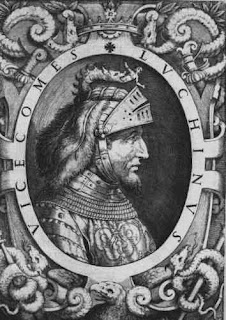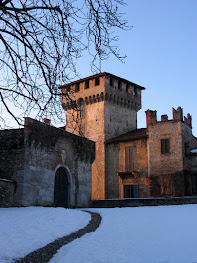Giuseppe Abbati - painter and revolutionary
Early death robbed Italian art of bright new talent
Italy lost a great artistic talent tragically young when the painter and patriot Giuseppe Abbati died on this day in 1868. Only 32 years old, Abbati passed away in the hospital of Santa Maria Nuova in Florence, having contracted rabies as a result of being bitten by a dog. Abbati was a leading figure in the Macchiaioli movement, a school of painting advanced by a small group of artists who began to meet at the Caffè Michelangiolo in Florence in the late 1850s. The group, in which Giovanni Fattori, Silvestro Lega and Cristiano Banti were other prominent members, were also for the most part revolutionaries, many of whom had taken part in the uprisings that occurred at different places in the still-to-be-united Italian peninsula in 1848. Abbati, born in Naples, had joined Giuseppe Garibaldi's Expedition of the Thousand, losing his right eye in the Battle of the Volturno in 1860, when around 24,000 partisans were confronted by a 50,000-strong Bourbon army at Capua, north of Naples. The son of Vincenzo Abbati, also a painter, Abbati was taken to live in Florence when he was six and to Venice before he was 10. Read more…
___________________________________________________________
Raimondo Montecuccoli – military leader
Brilliant tactician outwitted his opponents
Raimondo, Count of Montecuccoli, a soldier, strategist and military reformer who served the Habsburgs with distinction during the Thirty Years’ War, was born on this day in 1609 in Pavullo nel Frignano in the Duchy of Modena and Reggio. As well as being Count of Montecuccoli, Raimondo also became a Prince of the Holy Roman Empire and the Duke of Melfi in the Kingdom of Naples. He was born in the Castle of Montecuccolo in Pavullo nel Frignano near Modena and at the age of 16 began serving as a soldier under the command of his uncle, Count Ernest Montecuccoli, who was a General in the Austrian army. After four years of active service in Germany and the Low Countries, Raimondo became a Captain of Infantry. He was wounded at the storming of new Brandenburg and at the first Battle of Breitenfeld, where he was captured by Swedish soldiers. After being wounded again at Lutzen in 1632 he was made a major in his uncle’s regiment. He then became a lieutenant–colonel of cavalry. At the storming of Kaiserslautern in 1635 he led a brilliant charge and was rewarded by being made a colonel. Read more…
_________________________________________________________
Domenico Ghirardelli – chocolatier
Built famous US business with skills learned in Genoa
The chocolatier Domenico Ghirardelli, founder of the Ghirardelli Chocolate Company in San Francisco, was born on this day in 1817 in a village just outside Rapallo in Liguria. Also known as Domingo, Ghirardelli arrived in San Francisco in 1849 during the rapid expansion years of the Gold Rush, having spent the previous 10 years or so in Peru, where he had run a successful confectionery business. After making money as a merchant, initially ferrying supplies to prospectors in the gold fields, he set up his first chocolate factory in 1852, drawing on the skills he acquired as an apprentice in Genoa. By the end of the century, the Ghirardelli Chocolate Company was one of the city’s most successful businesses, with a prestige headquarters on North Point Street, a short distance from Fisherman’s Wharf, in a group of buildings that became known as Ghirardelli Square. The son of a spice importer, Ghirardelli was born in the village of Santa Anna, just outside Rapallo, about 25km (16 miles) along the Ligurian coast from Genoa, in the direction of La Spezia to the southeast. His father wanted him to have a trade and once he had reached his teens sent him to be an apprentice at a confectioner in Genoa. Read more…
_________________________________________________________
Death of Pope Julius II
Pope who commissioned Michelangelo for Sistine Chapel
Pope Julius II, who was nicknamed ‘the Warrior Pope’, died on this day in 1513 in Rome. As well as conducting military campaigns during his papacy he was responsible for the destruction and rebuilding of St Peter’s Basilica and commissioning Michelangelo to paint the ceiling of the Sistine Chapel. He is also remembered by students of British history as being the Pope who gave Henry VIII dispensation to marry Catherine of Aragon, his brother’s widow. Born Giuliano della Rovere, he was the nephew of Francesco della Rovere, who became Pope Sixtus IV. His uncle sent him to be educated by the Franciscans and he was made a Bishop soon after his Uncle became Pope. He later became Cardinal Priest of San Pietro in Vincoli in Rome and was very influential in the College of Cardinals. One of his major rivals was Cardinal Rodrigo Borgia, who was elected Pope Alexander VI in 1492. After accusing him of corruption, Della Rovere retreated from Rome until Alexander died in 1503. He was succeeded by Pope Pius III who died less than a month after becoming Pope and Della Rovere was finally elected as Pope Julius II in November 1503. Read more…

















